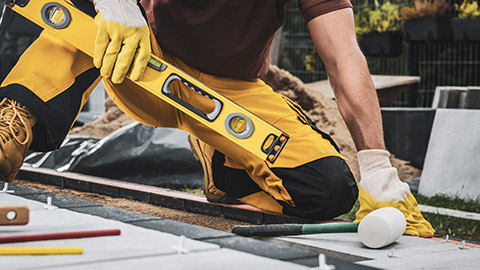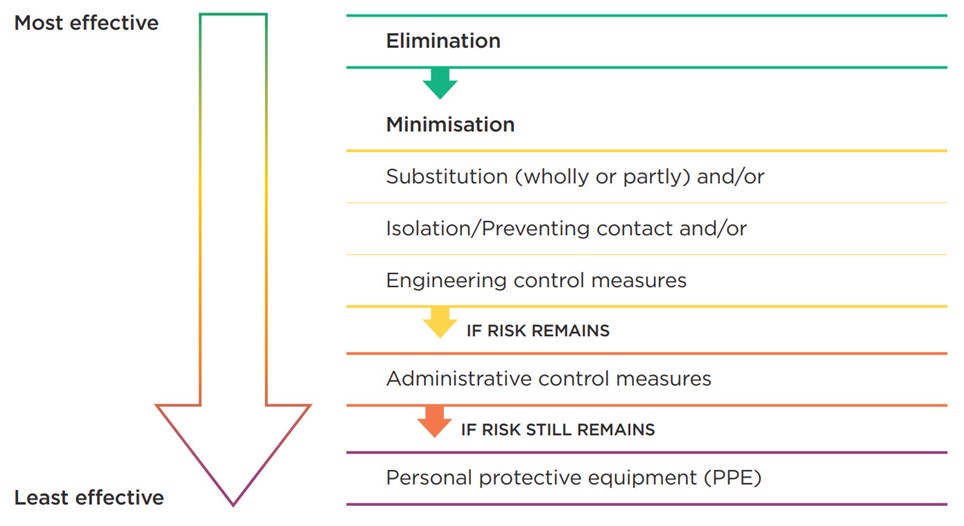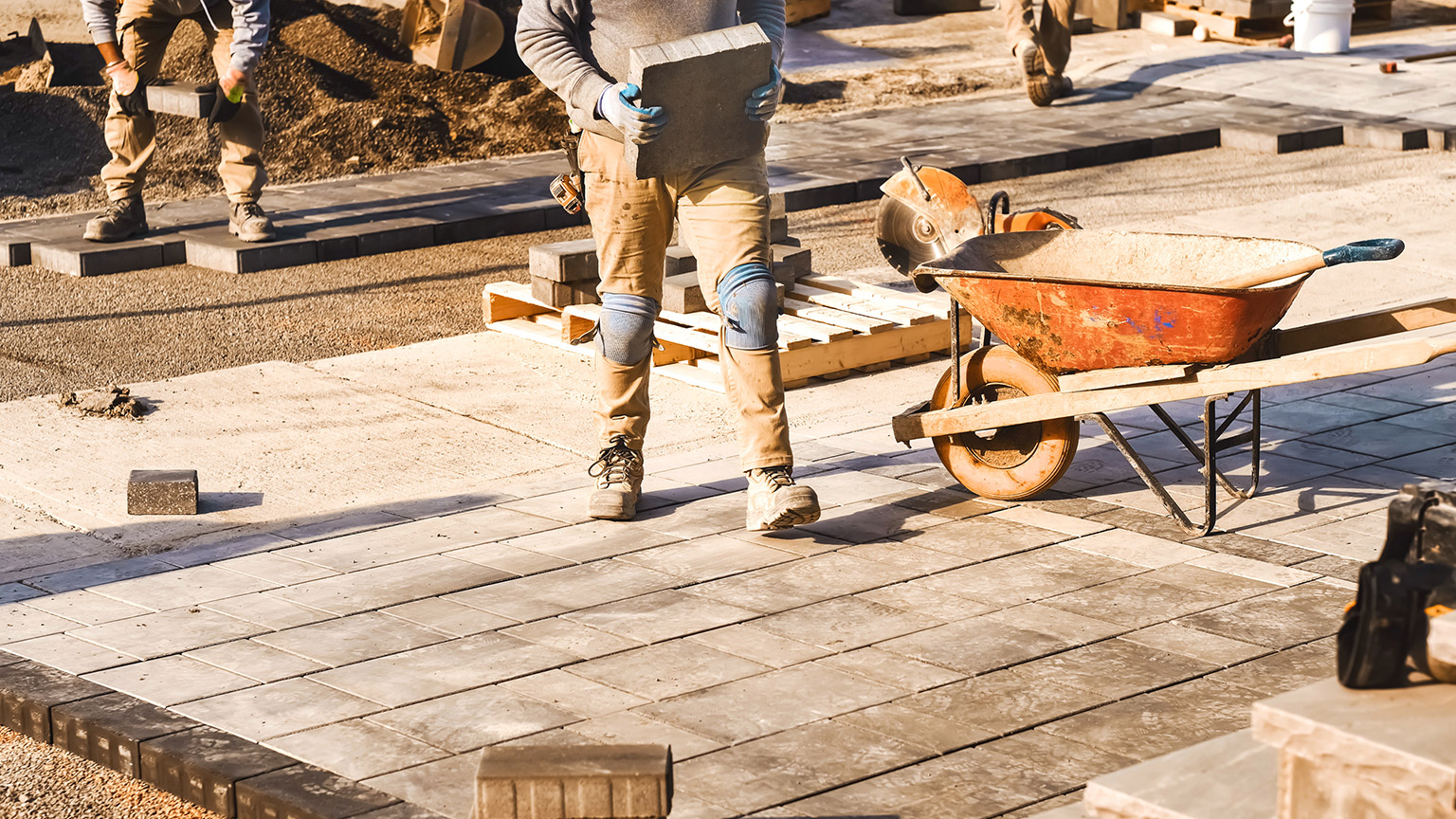This is the fifth module in the programme. It’s called Setting Out.
By now you have finished the design phase of the landscaping process so now we turn our attention to the construction phase. This begins with us setting out the location of planned landscape features on the site. After that we can start to install them.
By the end of this module, you will be able to:
- draw up a set-out plan, and
- work effectively as a member of a team to set out the real-world locations of key landscape features according to the plan.
The module has been created to:
- equip you with the knowledge, skills, and behaviours to work safely and effectively as a member of a landscape construction team
- give you the skills to draw a set-out plan for hard and soft landscaping features
- walk you through the process of setting out landscape features according to a plan.
Time to complete this module
This module is worth 8 Credits, which is roughly equivalent to 80 hours of learning. For some people it will take a little less time and for others it may take a little longer. Learning time includes reading, watching videos, completing learning activities, processing ideas, discussing what you’re learning with others, and completing the assessments.
You should aim to complete this module in:
- Full-time learners: 2 weeks
- Part-time learners: 4 weeks.
Assessment outline
To finish this module you need to complete two assessments:
LDB05A1: Draw a set-out plan: To do this you will need to:
- Decide on one hard landscaping feature and one soft landscaping feature that you will install in your chosen site.
- Produce a simple set-out plan to correctly locate these two features in the real world, which must include the following:
- site boundaries
- buildings onsite
- a benchmark
- one (1) soft landscaping feature
- one (1) hard landscaping feature
- dimensions to use to set out these features
- a title block.
LDB05A2: Set out a site: To do this you will need to:
- Work with at least one (1) other person to use the set-out plan to mark out the real-world location, and where appropriate, level/height, of the new site features.
- Contribute to the development of a hazard control plan, control site hazards, and adjust your own behaviour to work effectively with the other team members to complete the set-out.
- Ensure that photos are taken of the set-out in progress and the completed set-out.
- Get each teammate to complete a task verification form.
Go to the assessment section now and read the full assessment requirements.
We’re here to help!
Firstly, remember, it’s ok to make mistakes. When we make mistakes we can learn from them by thinking “what went wrong?” and “what can I do differently next time?”
Secondly, we’re here to help! If something doesn’t make sense, or you’re not sure what to do next, get in touch with your Tutor.

Whether you’re doing this programme to get into the landscaping industry or simply to spruce up your own garden, it’s essential that you do it safely.
As we move from landscape design to landscape construction, we start to face more risks to our safety and health and the safety and health of those around us.
In this topic we’ll explore a range of hazards you may encounter in residential landscape construction and introduce systems to help you reduce the risks they pose.
By the end of this topic you’ll be able to:
- define key health and safety terms (hazard, risk, harm, eliminate, minimise)
- identify workers’ legal responsibilities
- identify which risk controls are most effective
- write up a Work Risks and Control Plan for a landscaping project.
Under the Health and Safety at Work Act 2015 “a business or undertaking (PCBU) must look after the health and safety of its workers and any other workers it influences or directs.” (WorkSafe New Zealand, no date)
If you are getting paid to do this landscaping work, or doing it as part of a charity, you are deemed to be either a worker or a PCBU (person conducting a business or undertaking). If you are self-employed you are deemed to be a PCBU and a worker. If you are an employee, you are a worker.
If you are doing this landscape construction on the property where you live, and aren’t being paid for it, you are not considered a PCBU or a worker – it is not considered a workplace. However, it is still helpful to understand the key parts of the Health and Safety at Work Act 2015 (HSWA), because they offer useful guidance on how to keep yourself and others safe.
Hazards, risks, and harm
In the context of health and safety:
- A hazard is anything that has the potential to cause harm, including a person’s behaviour.
- Risk is “the chance that somebody will be harmed by a hazard. An indication of how serious that harm could be.” (Education Office, no date)
- Harm means injury or ill-health and includes mental health.
For example, 600x600mm concrete pavers can weigh upwards of 40kg each. Accordingly, each paver could be considered a hazard because there is a reasonable chance that you would hurt yourself if you moved one by yourself. Possible risks of working with these pavers are:
- back injury when lifting, carrying, or lowering the paver
- crushed feet if the paver were to fall while being carried
- crushed fingers when positioning the paver.
These three scenarios are risks because there is a chance of each happening and if it does happen it will result in harm.
Another example of risk is a worker who is sleep-deprived, as they are far more likely to make poor decisions, which may lead to them being injured or injuring someone else.
The primary duty of care of a PCBU
The primary duty of care means that the business (which could be you if you are self-employed) or undertaking is responsible for the health and safety of its workers, and other people on the worksite. To meet its obligations, the PCBU must:
- Provide and maintain a work environment that is without risks to health and safety.
- Provide and maintain safe plant and structures.
- Provide and maintain safe systems of work.
- Ensure the safe use, handling and storage of plant, structures and substances.
- Provide adequate facilities for the welfare of workers.
- Provide information, training, instruction, or supervision necessary to protect all people from risks to their health and safety arising from the work.
- Monitor the health of workers and the conditions at the workplace for the purpose of preventing injury or illness of workers. (WorkSafe New Zealand, no date)
Responsibilities and rights
The HSWA requires that both PCBUs and workers manage risks by:
- eliminating those risks wherever possible, or where that is not possible
- by minimising the risks as far as reasonably practicable.
Reasonably practicable means taking all necessary actions unless they are disproportionately expensive.
The PCBU must engage with workers and give a reasonable opportunity to the workers –
- “to express their views and to raise work health or safety issues in relation to the matter; and
- to contribute to the decision-making process relating to the matter” (Health and Safety at Work Act 2015 No 70 (as at 23 December 2023), Public Act Contents – New Zealand Legislation, 2024 section 59).
The PCBU must take those views into account and advise workers of the outcomes or actions taken as a result.
Workers must:
- take reasonable care of their own health and safety
- take reasonable care to make sure their actions or inactions don’t harm other people
- comply with reasonable instructions of the PCBU
- follow reasonable policies and procedures of the PCBU relating to health or safety at the workplace (Health and Safety at Work Act 2015 No 70 (as at 23 December 2023), Public Act Contents – New Zealand Legislation, 2024 section 45).
Watch
WorkSafe Induction Video
This video provides a high level overview of worker’s rights and responsibilities when it comes to health and safety.
Expected Duration: 3:30 minutes
Questions
Pre Watch Question: As you watch the video, consider the following questions:
- What are 3 health and safety rights you have as a worker?
- What are 3 health and safety responsibilities you have as a worker?
A key part of health and safety is identifying, assessing, and managing work risks. Mahi Haumaru Aotearoa Worksafe New Zealand has produced a reference guide that explains this process more fully. If you’re interested, you can download it here:
Quick Guide: Identifying, Assessing and Managing Work Risks: July 2017
The key points are summarised below.
Worksafe recommends following the Plan-Do-Check-Act approach:

- Plan: identify and assess the risks
- Do: eliminate or minimise the risks
- Check: monitor the control measures
- Act: review for continuous improvement
Plan: Identify and assess the risks
Before we can take action to reduce risks, we need to know what risks we face, how likely they are to happen, and the consequences if they do occur.
If you’re working as part of a team, it’s essential that you involve everyone in this process. This is often done by having a tailgate meeting or toolbox talk. We’ll talk about these later.
Identifying risks
Think about all the things that could cause you, or others, harm:
- from the surrounding environment, such as sunburn, wind-burn, hypothermia
- on the worksite as it exists before you start, considering:
- overhead risks, such as power lines
- surface risks, such as surfaces that could lead to slips, trips, and falls
- underground risks, such as buried electrical cables, water and sewage.
- as a result of your work, such as:
- the tools you bring onto site
- The things you construct on site, for example holes you dig and stringlines you set up
- As a result of people on the worksite, for instance, their behaviours, degree of mobility, or other impairment such as being under the influence of drugs or alcohol.
Consider both injury and illness risks
Don’t only think about things that can cause injury, also consider things that may lead to illness. Some examples of risks that can lead to illness are:
- Legionnaires' Disease can be contracted by inhaling dust from soil, compost, or potting mix that contains legionella bacteria.
- Silicosis is a long-term lung disease that is caused by inhaling (breathing in) silica dust, such as when filling the gaps between pavers with paving sand.
- “You can develop hand-arm vibration syndrome (HAVS) or carpal tunnel syndrome (CTS) if you regularly and frequently use hand held power tools and machines, especially for long periods of time.”
In Aotearoa, every year up to 900 people die from illnesses caused by their work and another 30,000 suffer new cases of serious ill-health.
The number of deaths from workplace illness is roughly 20 times that of the number of people who die from workplace injury each year. (WorkSafe New Zealand, 2016)
Assessing risks
For each of the above risks, give an educated guess about:
- how likely it is to happen (likely, possible, or rare)
- what the consequences may be if it did happen.
Determining risk controls
For each risk, go on to choose one or more control measures. A risk control measure is the action you will take to eliminate or minimise the risk.
You must eliminate the risk if this is reasonably practicable to do so.
If you can’t eliminate the risk, choose risk minimisation controls.
Use of personal protective equipment (PPE) such as safety footwear is considered the last line of defence and should only be specified as a control in combination with other controls.
When choosing controls, Worksafe recommends using the hierarchy of controls, and choosing ones that are most effective.

The following table gives a brief explanation and example of each of these control categories. The example relates to a hole that has been dug in the ground that could cause people to suffer a fall and potentially break their ankle.
| Control category | Description | Example |
|---|---|---|
| Elimination | Removing the risk entirely. | Fill in the hole. |
| Substitution (minimisation) | Using a less dangerous alternative. | Contract directional drilling company to achieve the objective. As a result there will be no large hole. |
| Isolation (minimisation) | Putting up physical barriers to make it impossible to come in contact with the hazard. | Boarding over a hole until it is ready to be filled in. |
| Engineering controls (minimisation) | Adding safety guards to tools or handrails to stairs. | Erecting temporary fencing around the hole. |
| Administrative controls (minimisation) | Using recognised safe work practices. | Putting up barrier tape around the hole and communicating this risk to all people on site. |
| PPE (minimisation) | Safety clothing and equipment such as ear protection and eye protection. | Requiring workers to wear safety boots with good ankle support. |
Writing up the plan
As you work through the steps above, record this information in a table. You might like to use this Work Risks and Control Plan template.
Do this each time you are doing landscape construction work. For instance, do one prior to doing your set-out assessment and then another for when you are installing your landscape features.
When writing up the potential harm and likelihood columns, do this based on there being no controls in place.
An example of a completed Work Risks and Control Plan is provided here.
Do: Eliminate or minimise the risks
Follow through with your control measures. Implement those things that require physical controls, such as setting up barriers or temporary fencing.
It’s essential that you communicate all risks that have not been eliminated and explain the controls in place. This is especially important for administrative controls and PPE, because these rely on people knowing the correct action.
Check: Monitor the control measures
Controls only reduce risk when they are in effect. In other words, if people aren’t following safe working practices or aren’t wearing PPE correctly, the risk is not controlled. If this is the case, they are just as likely to be injured or become ill as a result.
Periodically check that all controls are in place and working correctly.
Make sure that you, and your teammates are wearing the correct PPE and wearing it correctly. For example, the correct grade of earmuffs for the job at hand.
Act: Review for continuous improvement
Review the plan periodically as a team and update it accordingly. If new risks are identified, bring the team together and work through the risk assessment and control steps explained above.
If you think of better ways of controlling hazards and risks, use those approaches from then on.
Activity: Check you understanding workplace risks and controls
Test your understanding of risk control by solving some of the case files at pickled.nz, a game about protecting safety and health at work.
Do as many as you like. The most relevant one at the time of writing is Coming Up Roses, but you may also find some useful memory joggers in:
A toolbox talk, also known as a tailgate meeting, is a safety meeting that involves all workers on site. It’s a good way of:
- reviewing site hazards and risks
- agreeing on appropriate controls
- communicating the hazards, risks, and controls with the team.
When running a toolbox talk, have your Work Risks and Control Plan handy so you can discuss the content with your team.
This one-pager by Site Safe explains how to run a toolbox talk.
Reading
How to run a toolbox talk
This quick reference guide explains why toolbox meetings are important and gives suggestions for how to run them and what to cover.
sitesafe.org.nz/globalassets/factsheets/how-to-run-a-toolbox-talk-2017.pdf
Expected Duration: 2 minutes
Questions
Pre Read Question: Have you ever participated in a toolbox talk? Did you feel comfortable to raise concerns in the meeting?
Post Read Task: Did any suggestions in this document jump out at you as really good ideas to include in a toolbox talk? What were they?
The key thing to remember, and remind others, is that health and safety is all about making sure everyone goes home to their whānau at the end of the day.
As we move on to the physical tasks of setting out, and later the installation of landscape features, we’ll highlight hazards and risks commonly associated with those activities. And, where appropriate, we’ll describe safe working practices. However, it must be noted that it is your responsibility to identify and control risks throughout the landscape construction phase; it's an ongoing process.
We’re almost at the end of this topic. Complete the quiz below to check your understanding.
In the topic we introduced you to Aotearoa’s health and safety framework and looked at ways of using this to work safely in landscape construction.
Health and safety legislation doesn’t apply if you are landscaping the property where you live, and aren’t being paid for it, but it still makes sense to use the relevant plans and techniques to keep yourself and others safe.
